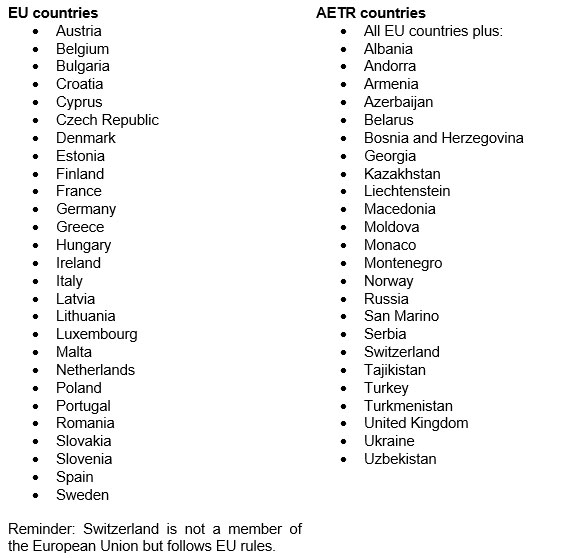
Within Great Britain (GB), either GB domestic or EU rules may apply. Which set of rules applies depends on the type of driving and the type of vehicle being used.
For international journeys, either the EU or the AETR (European Agreement Concerning the Work of Crews of Vehicles Engaged in International Road Transport) rules may apply.
Most vehicles used for the carriage of goods by road and with a maximum permissible weight (including any trailer or semi-trailer) of over 3.5 tonnes are in scope of the EU rules, unless covered by a specific EU-wide exemption or a national derogation.
International journeys to or through countries that are outside the EU but are signatories to the AETR are subject to AETR rules.
It should be noted that from 21 May 2022, all vehicles that fall into the category Light Goods Vehicles (LGVs), which include cars towing trailers for commercial reasons on International Journey must now adhere to EU Drivers Hours Rules. For more information on this, please go to Light Goods Vehicles Section and the page Light Goods Vehicles and the EU for further detailed information.
Carriage by road
‘Carriage by road’ is defined as any journey, made entirely or in part on roads open to the public, of a vehicle, laden or unladen, used for the carriage of passengers or goods. ‘Off-road’ driving is in scope of the rules, where it forms part of a journey that also takes place on public roads. Journeys that are made entirely off road are out of scope of any drivers’ hours rules however under EU/AETR record keeping rules, drivers who carry out any EU/ AETR regulated work must record all periods of off-road driving as ‘other work’.
Goods
The term ‘goods’ includes goods or burden of any description. It does not include parts of a vehicle or trailer’s fixed equipment manufactured as part of the vehicle or trailer, and which enables the extension of fixed equipment. It also does not include ballast used for the purpose of road testing a vehicle or trailer, or for MOT or annual test purposes provided, the ballast is a non-commercial load.
Non-commercial carriage is defined as any carriage by road, other than carriage for hire or reward or on own account, for which no direct or indirect remuneration is received and which does not directly or indirectly generate any income for the driver of the vehicle or for others and which is not linked to professional or commercial activity.
A trailer (including anything permanently attached to it) is not “goods” unless it being wholly carried on a vehicle or another trailer.
International journey
An international journey means a journey to or from the UK and includes the part of the journey within the UK.
For journeys that are partly in the EU and partly in countries that are in neither the EU nor signatories to AETR, EU rules will apply to that portion of the journey that is in the EU. Countries outside the EU and AETR are likely to have their own regulations governing drivers’ hours, which should be adhered to while driving in that country.
Most vehicles that are exempt from the EU rules come under GB domestic drivers’ hours rules while engaged on domestic journeys.

EEA countries
All the EU countries plus – Iceland, Liechtenstein and Norway
Rules for Employers
EU rules
Even though the UK has left the EU, drivers still need to follow EU rules on drivers’ hours and tachographs.
The EU rules apply if the maximum weight of the vehicle or vehicle combination is more than 3.5 tonnes and you are driving either:
Driving hours
The main EU rules on driving hours are that you must not drive more than:
You must record all driving you do under EU rules on a tachograph.
Breaks and rest
The main points of EU rules on breaks and rest are that you must take:
Coach drivers on an international trip can take their weekly rest after 12 consecutive 24-hour periods, starting from the end of the last weekly rest period taken.
If driving goods vehicles on an international trip, they can take 2 consecutive reduced weekly rest periods (less than 45 hours) as long as these are taken:
Over a 4-week period, 2 of the weekly rest periods must still be of at least 45 hours.
For more details on rests and breaks read:
Goods vehicles: rules on drivers’ hours and tachographs
Passenger vehicles: rules on driver’s hours and tachographs
Source – DVSA